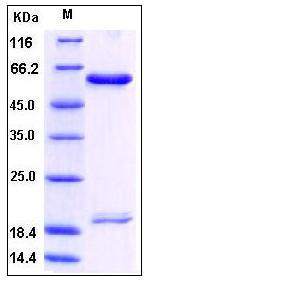Human PCSK9 / NARC1 Protein (His Tag)
FH3,HCHOLA3,LDLCQ1,NARC-1,NARC1,PC9
- 100ug (NPP1562) Please inquiry
| Catalog Number | P10594-H08H |
|---|---|
| Organism Species | Human |
| Host | Human Cells |
| Synonyms | FH3,HCHOLA3,LDLCQ1,NARC-1,NARC1,PC9 |
| Molecular Weight | The recombinant human PCSK9 consists of 662 amino acids and predicts a molecular mass of 72.6 kDa. As a result of glycosylation and proteolytic digestion, rhPCSK9 migrates as doublet with apparent molecular mass of 20 kDa and 62 kDa respectively in SDS-PAGE under reducing conditions. |
| predicted N | Gln 31 |
| SDS-PAGE |  |
| Purity | > 97 % as determined by SDS-PAGE |
| Protein Construction | A DNA sequence encoding the human proprotein convertase 9 (AAV67948.1) (Met 1-Gln 692) was expressed with a C-terminal polyhistidine tag. |
| Bio-activity | Measure by its ability to bind with human LDLR in a functional ELISA . Immobilized recombinant human PCSK9 at 10 μg/ml (100 μl/well) can bind biotinylated human LDLR . The EC50 of biotinylated human LDLR is 0.61 μg/ml . |
| Research Area | Developmental Biology |Metabolism |Pathways and Processes |Metabolic signaling pathways |Lipid and lipoprotein metabolism |Lipid metabolism | |
| Formulation | Lyophilized from sterile PBS, pH 7.4 1. Normally 5 % - 8 % trehalose and mannitol are added as protectants before lyophilization. Specific concentrations are included in the hardcopy of COA. |
| Background | Proprotein convertase subtilisin/kexin type 9 (PCSK9), also known as NARC1 (neural apoptosis regulated convertase), which is a newly identified human secretory subtilase belonging to the proteinase K subfamily of the secretory subtilase family. PCSK9 protein is an enzyme which in humans is encoded by the PCSK9 gene with orthologs found across many species. It is expressed in neuroepithelioma, colon carcinoma, hepatic and pancreatic cell lines, and in Schwann cells. PCSK9 protein is highly expressed in the liver and regulates low density lipoprotein receptor (LDLR) protein levels. Inhibition of PCSK9 protein function is currently being explored as a means of lowering cholesterol levels. Thereby, PCSK9 protein is regarded as a new strategy to treat hypercholesterolemia. PCSK9 protein contributes to cholesterol homeostasis and may have a role in the differentiation of cortical neurons. |
| Reference |
